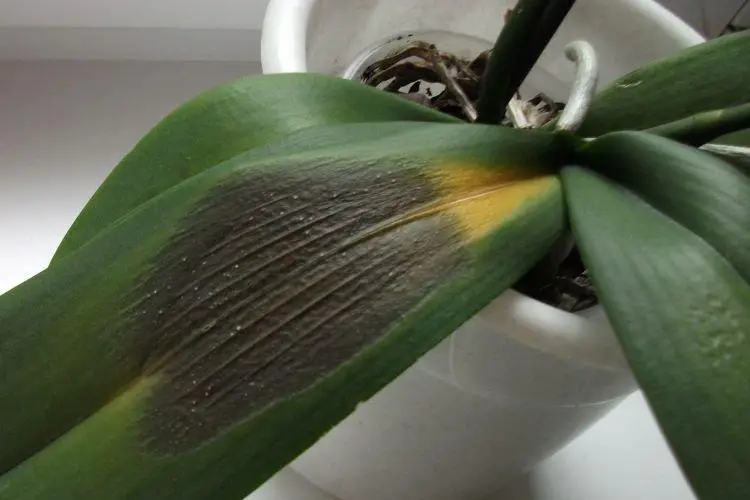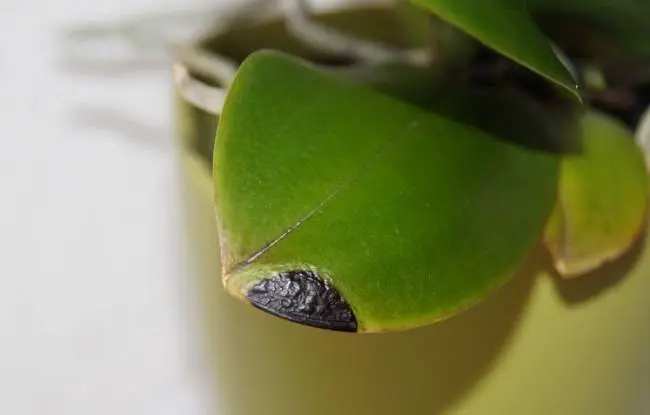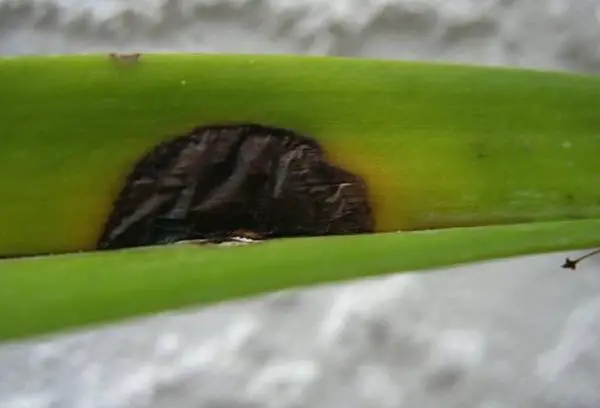Signs and symptoms of orchid leaves turning black and dark spots indicate that the flower is exposed to the disease and requires treatment.
If measures are not taken in time, then the flower may die.

Are black orchids natural?
Sometimes a black leaf is inherent in a certain type of orchids, and in summer the color of the leaf plate becomes a little brighter than the winter version.
The following species of orchid have black leaves nature:
- Ludisia its variegated leaves have a dark crimson hue. Homeland – East and Central Asia;
- Phalaenopsis Schiller – has colored leaves with a red tint. Homeland – Philippines.
Why orchid leaves turning black?
Why did the orchid leaves turn dark and why is this happening? Sometimes, when buying in the winter, the grower acquires a flower with ordinary green leaves. And after a while, he notices that the leaf began to darken, but at the same time he does not look sick or affected. Orchid leaves may darken in winter.
If the leaf has not lost its turgor and no lesions or harmful insects are found on it, it can be said that with the onset of spring, under the influence of ultraviolet radiation, the leaves change their color to a darker one. The flower seems to tan under the influence of sunlight. Do not confuse it with the burn of the same leaf, when the flower is exposed to the sun and the leaves simply burned out from an excess of ultraviolet radiation.
Symptoms of orchid leaves turning black
Under the influence of the disease, the plant changes color on leaf plates. Spots of various colors and types may appear on them, which will signal improper care for the orchid.

black spots on orchid leaves
black Spots On Orchid Leaves occur when:
- High indoor humidity;
- Or frequent irrigation of the leaves;
- And also, if during this period the air temperature is low.
Therefore, oval spots of a dark brown hue appear on the leaves. They initially have a diameter of 3 mm. Later they begin to grow. To cure a flower, you need:
- Cut off the damaged part of the sheet;
- Treat the cut with an antiseptic and fungicide;
- After that, the plant is taken out to a room with warmer air and humidity is monitored.
orchid leaves veins turns black
Leaf veins can darken for two reasons:
- Nutrient deficiencies;
- An excess of nutrients.
Due to the lack of Potassium and Phosphorus leaves:
- Stop growing;
- And they can change their color.
- Due to the lack of potassium and phosphorus, the leaves of the orchid may darken.
Also, with an excess of trace elements, the plant transfers too much mineral fertilizers from the roots to the leaf, and the leaf cannot cope with this, getting a burn of the leaf tissues.
IMPORTANT! Apply fertilizers only according to the instructions, without increasing the dose.
Orchid leaf tissue dies
Leaf cells die when:
- thermal burn;
- Or frostbite in winter.
To get rid of the stain, if the damaged area is small, then it:
- Trimmed ;
- Treated with brilliant green and the appropriate fungicide.
If the lesion is close to the trunk, then the leaf is removed completely. This will prevent infection of the entire plant.
Wet black spots on orchid
If we exclude that this is the action of ultraviolet radiation, then this is a bacterial disease. The spots spread quickly and destroy the plant. This gives off an unpleasant odor. To save the plant, you must:
- Trim the leaves to a healthy place;
- And treat all sections with Trichopolum;
- And shed the plant with a solution of tetracycline 500 mg., Diluting the tablet in a liter of water.
black rot in middle orchid leaves
This is a bacterial rot that appears on the leaves of the plant and spreads through it . To get rid of it, you need to cut off all the blackness to a healthy place and treat the leaf with an insecticide. Spraying is carried out 2-3 times until the threat of infection of the plant disappears.
When rot appears on the leaves of an orchid, it must be removed.
To avoid this disease, plants must be placed freely so that they have access to air.
water spots on orchid leaves
Brown bacterial rot mainly appears on young leaves due to improper watering. To get rid of this disease:
- Stains are cut off with a sharp disinfected instrument;
- And the sections are treated with charcoal or a copper-containing preparation.
The disease is contagious for other plants , and therefore the diseased plant must be immediately put aside in a quarantine zone until the end of treatment.
black plague orchid leaves
Soot fungus occurs as a consequence of harmful insects such as:
- Shchitovka;
- Or a mealybug.
Therefore, first we get rid of pests by treating the flower with the appropriate chemical preparation – Actellik. Processing is carried out in stages, three times, with an interval of 5-6 days. To get rid of a fungal disease, the following drugs are simultaneously used:
- Speed;
- Ridomil;
- Or Mikosan.
Causes of orchid leaves turning black

If the tips of the leaves darken, this indicates that it does not receive proper care. Most likely, the room has low humidity and there are cold drafts. To restore the disturbed balance, it is necessary:
- Restore temperature balance;
- Trim the blackness on the leaves and process the sections;
- If there was overfeeding with fertilizers, then stop feeding for six months. Darkening at the tips of the leaves is due to a violation of the temperature regime.
IMPORTANT! If you follow the generally accepted norms for cultivating orchids, there will be no problems with the leaves.
Check out fix to Orchid Buds Falling Off Indoor.
Main reasons of orchid leaves turning black
All diseases occur due to improper care of the orchid. In order for the plant not to hurt, it is necessary for it:
- Follow the rules of care;
- And find him a place in the room so that he has enough diffused sunlight for vegetative development.
Dry or too humid indoor air
Dry indoor air leads to the appearance of harmful insects, which, located on the plant, feed on its juice. The leaves then become unusable and crumble, which leads to the death of the plant.
Too humid air is a good environment for the progressive growth of bacteria and spores of various fungal diseases.
IMPORTANT! Find a middle ground by choosing the humidity of the air, since extremes lead to disease, and sometimes death of the plant.
Inappropriate watering
Incorrectly selected watering, namely the bay, leads to the spread of various diseases:
- Fusarium;
- Various rots;
- Bacterial diseases.
Watering should be carried out as needed by the root system, and not just according to calendar days.
Heat
At high temperatures, the plant can get a heat burn on the leaf plates. This is not treated, and the leaf will have to be removed. To prevent this from happening, you must:
- For the summer period, flowers are taken out of the south direction room; It is necessary to observe the temperature regime for the orchid.
- And in winter, a hot radiator is covered with a thick cloth or blanket.
hypothermia
Orchid hypothermia leads to:
- To her frostbite;
- And the appearance of wet spots on the leaves.
To prevent this from happening, it is necessary not to place the flower close to the cold glass or window. And when transporting in winter, it is good to wrap the flower.
Pest infestations
In addition to the pests drink juice from a plant leaf, they attract a fungal disease with their sticky secretions and soot fungus. Therefore, treatment is carried out in a complex way, getting rid of both pests and fungus.
Infectious diseases: fusarium, mosaic, septoria, bacterial rot
All these diseases develop due to improper care :
- unregulated watering;
- Without access to fresh air;
- Crowding of plants in the place of growth.
Plants must be grown in proper conditions with normal light, and humidity, and then diseases will not occur.
Check out Orchid Fusarium Treatment.
Treatments for orchid leaves turning black

In order for the treatment to be successful, it is necessary to fulfill certain requirements for its treatment, and then the resuscitation process will go more intensively towards recovery.
Insulation
Noticing any disease on the plant, you must immediately set it aside in the quarantine zone, this will help save the rest of the plants. After all, if there is a virus on the plant, then it will have to be destroyed, and if it is not removed to the side, the entire collection will have to be destroyed.
IMPORTANT! Isolating a diseased orchid will help save the rest of the plants in the collection.
Pruning the stalk
The peduncle is cut off due to the fact that the plant does not expend energy on it, but lets them recover after treatment.
The stalk of the orchid is cut off so that the plant does not waste strength.
The orchid is weakened at the time of illness, and the forces used for flowering may be the last that the flower has. Having grown buds, the rosette of leaves can simply die.
In case of pest infestation
First of all, you first need to determine the harmful insect that the orchid has acquired. After that, with your hands or a cotton swab from hard-to-reach places:
- Remove all insects;
- And visible deposits.
Then the plant is treated according to the instructions given on the package. The drug is also selected according to the pest that is located on the plant. Do you want to Get Rid Of White Sticky On Orchids.
For fungal diseases
In this disease, all spots or other damage are cut out to healthy tissue.
The rest is treated first with charcoal and then with a fungicide so that the spores of the fungus do not spread throughout the plant.
The plant remains in quarantine for another 2 weeks to make sure it is healthy.
Restoration of the temperature regime and irrigation regime
To restore the temperature regime, the plant is transferred to a room where the air temperature is in the range of 23-25 degrees Celsius.
The correct watering regime is when the condensate on the container inside the pot disappears, and the roots of the plant turn light gray. Watering in summer – about once every 7-10 days, in winter depending on the room temperature from 3 weeks to 1.5 months.
transplanting orchid
If the orchid had a damaged root system, then transplant:
- It is extracted from the bark;
- And cut out all the injured or dry. When the leaves darken, the orchid is often transplanted.
After that, all slices are processed:
- Charcoal;
- Or another antiseptic;
- And then a systemic fungicide so that the disease does not spread further.
After all the manipulations, the root system is dried for 8 hours and planted in a new substrate. The first watering is carried out on the 4th day.
IMPORTANT! If the root system has suffered by 70%, then it must be reanimated in order to grow new roots.
Conclusion
If orchid leaves turning black, you need to decide what disease they belong to and start treatment. Most often, an orchid can be helped and it will delight the grower with its beautiful flowering for a long time to come.
